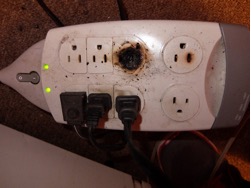 Last month in this blog, I chronicled a “device failure”: my car key broke off in the ignition. I modeled this “exception” (to my reasonable expectations) using Python code, suggesting pseudo-coding one’s risk model as a first step in a risk assessment process.
Last month in this blog, I chronicled a “device failure”: my car key broke off in the ignition. I modeled this “exception” (to my reasonable expectations) using Python code, suggesting pseudo-coding one’s risk model as a first step in a risk assessment process.
In the case of an ignition key snapping off, the operator is right there to witness the failure. Failures do not always have witnesses. Some days ago, one of my power strips failed and suffered a small electrical fire internally.
The strip helped channel power to a pet aquarium in room rarely used by the pet’s owner. Hours if not days elapsed before I discovered the evidence of a meltdown.
 The Internet of Things is about making it easier for devices to patch in to a central nerve system with a control panel, that advises when power strips or smoke detectors are coming to the end of their life cycle.
The Internet of Things is about making it easier for devices to patch in to a central nerve system with a control panel, that advises when power strips or smoke detectors are coming to the end of their life cycle.
Devices amortize themselves, signalling when maintenance is required. Perhaps simply a new battery is needed, like on my Mac Air, which also suggests workflows for addressing the issue: make an appointment at the local Genius Bar.
Rather than visiting each device “in situ” (where it lives), the control panel acquires information by wifi. Home and / or office maintenance is presumably then less a matter of an overwhelming number of details leadingto neglect. Anticipating and preventing failures that might have been catastrophic now enter the realm of “routine”.
Once your enterprise has established a risk management control panel or dashboard, anticipating failure, versus always playing catch-up, becomes the name of the game.
Fewer surprises means less stressful distractions and unplanned-for down time.